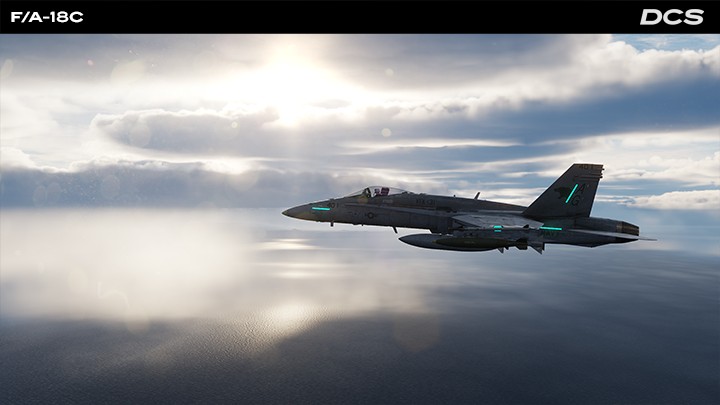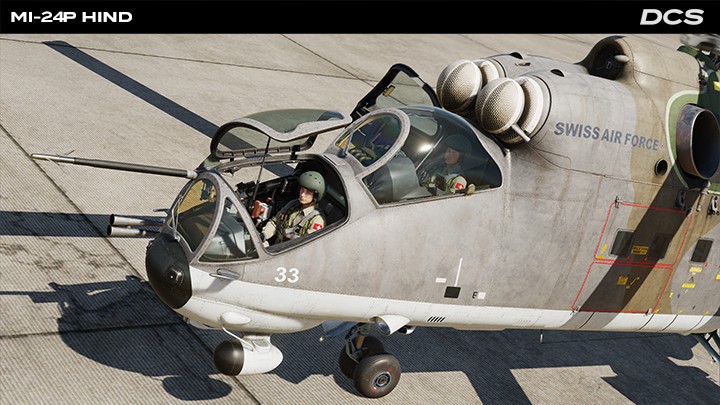|
06 October 2023
Dear Fighter Pilots, Partners and Friends,
We are pleased to inform you of the most recent changes coming to the F/A-18C and F-16C air-to-air radar detection modelling. Notably, we have further refined how the radar detects targets based on a realistic set of probabilities. Take a look at the technical explanation below. Stay tuned for the feature drop in the upcoming DCS 2.9 Open Beta!
DCS: Mi-24P Hind will also receive a wealth of improvements in the upcoming open beta update! You can look forward to exciting Petrovich AI enhancements and an updated SPO-10 Radar Warning Receiver (RWR). More details below.
Bogey Dope is an ex-USAF F-16 Crew Chief that creates easily digestible DCS tutorials, cinematics, and missions on YouTube. His channel is a great resource for DCS pilots, and we encourage you to check out his channel and show him your support!
Please note that if your Steam account is bound to your DCS account, you will not be able to log into the Steam version of the game and will encounter a 403 error. This change has been implemented to enhance security and streamline access to DCS.
Thank you for your passion and support.
Yours sincerely,
Eagle Dynamics
|
Air-to-Air Radar
Improvement

In our previous White Paper regarding Phase 1 of improving the F-16C and F/A-18C radars, we discussed advances in how we calculate detection range based on Pulse Repetition Frequency (PRF), average transmitted power, receiver noise figure, antenna area, and Signal to Noise Ratio (SNR). You can find this White Paper here:
Eagle_Dynamics_Radar_White_Paper_v1 (digitalcombatsimulator.com)
For Phase 2 of radar model update, we will be accounting for the following:
Fluctuation of Target RCS. Real targets have complex shapes, and their linear sizes are often larger than radar wavelength. This means that radar returns from different parts of the airframe may add or cancel each other depending on their relative phase causing the RCS to fluctuate. In our approach, RCS is approximately constant during dwell, but randomly changes from dwell to dwell according to exponential distribution (this approach is known as the Swerling Case I model). This results in non-constant detection range and target detection probability.
Noise Variability. Detection probability will also depend on the noise level, its variability, and the number of Coherent Processing Intervals (CPIs) per dwell. Because the noise level continuously changes, the target may or may not be detected in a particular CPI. For example: There are three CPIs per dwell in HPRF RWS mode, and for successful ranging, the target should be detected in all three CPIs. Obviously, the probability of detection in all three CPIs is lower than the probability of detection in one of three CPIs or in three of eight CPIs (like in MPRF mode). In HPRF Velocity Search mode, Post-Detection Integration (PDI) replaces Frequency Modulation Ranging (FMR). In that mode, signals from three CPIs are summed to make noise fluctuations smaller and thus minimise the probability of false alarms. This allows lower threshold sensitivity and increased detection range without increasing false alarm probability.
Mode-Specific Range and Doppler Resolution. Closely spaced targets may not be resolved individually, and they may be displayed as a single target. Return energy off such targets may fall into a single doppler range bin and result in detection at longer ranges. Velocity resolution depends on CPI duration. So, in HPRF with three CPIs per dwell resolution is better than that in MPRF mode with eight CPIs per dwell (dwell duration is constant, so CPIs are shorter). In RAID mode, up to four CPIs may be merged into one, thus increasing velocity resolution four times. RWS HPRF mode uses linear frequency modulation for ranging, and it has poor range resolution (in order of 2 nm, which improves four times in RAID mode). In MPRF mode, range resolution is defined by range bin size and it is always equal to 150 meters.
Atmospheric Propagation Loss. The atmosphere absorbs radio waves proportional to its density. So, at higher altitudes, detection range is greater than at low altitude.
In summary, the Phase 2 changes provide a more realistic simulation of radar detection probabilities that will have more variable detection ranges, low-quality/spurious detections, more accurate RCS effects, and modelling of radar modes.
In Phase 3 we will focus on false targets, look-down performance, and improved modelling of Single Target Track (STT) mode.
|
Mi-24P Hind
Development Progress

Recent DCS: Mi-24 Hind development has focused on additional Petrovich AI features, an SPO-10 RWR system update, and tuning of the swashplate control limits.
Petrovich AI is getting new and more realistic target scan behaviour to deal with the same issues that real crews cope with. You may have noticed that Petrovich AI now lists all the targets he can see only after his sight is enabled and can be slewed. We've decided to improve this interaction with Petrovich AI by restricting him to the same limits as a human operator.
The new target scanning system involves a deeper analysis of the target area and its surroundings. It will analyse the target area for any threats in the vicinity. After that, the algorithm calculates the search time based on the number of objects surrounding the target. With this new system, only targets that are clearly in view will be recognized instantly, while targets that are hidden by trees, bushes etc. will take longer to spot. The more objects surrounding the potential target, the longer it will take for Petrovich to detect it.
The updated SPO-10 RWR will consist of four channels with completely independent processing, the same as in the real system. The radar detection calculations are physics based, they calculate the radiation pattern of the transmitting source, the sensitivity of the receiving antennas, and the transmitting power of the emitter. This translates to detecting low-power radar emitters and shorter range and vice versa. Detection range will also vary based on bearing to the emitter source. For certain radars, the range can also be judged based on how frequent the detections are. The system will now only detect emission sources within the operating frequency range of the RWR. For instance, early warning and search radars and some other radar types will not be detected.
We are also refining the pitch and roll channels authority based on comparison data. Our earlier version was based on the Mi-24V swashplate limits. Compared to new Mi-24P data, it should have less authority in pitch and roll, and we are correcting this discrepancy. This will make DCS: Mi-24P Hind more responsive to pitch and roll input changes.
|

